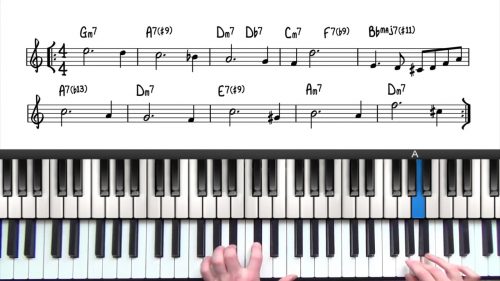Boogie-Woogie Chords & Rhythms
In this lesson, we’ll learn some basic right-hand chord voicings and rhythms, and some specific riffs you can use in many places, and that you will hear in many boogie-woogie songs.
As mentioned in the last lesson, the left-hand plays the role bass player and drummer. Now we’ll look at how the right-hand gets to dance to the groove they are laying down.
Adding Right Hand Syncopation
We’ll start by taking one of the basslines we learned in the last lesson, and lay down a right-hand chord on top, adding some rhythm and syncopation.
A simple syncopation is changing the normally accented beats to unexpected places. When you hear the accents fall in unexpected but ‘cool’ places, it engages the brain and makes the listener pay attention.
6th and 9th Rootless Voicings
Boogie-woogie uses a lot of 6s and 9s in the chord voicings. When moving from the I to the IV chord. Just one note changes to become a IV9 chord.
In jazz, these are called rootless chords voicings. If you are new to this style of voicing, check out the related lessons below.
Chromatic Chord Movement
One thing you’ll hear a lot in boogie-woogie is chromatics. This is moving to a note or interval from the half-step above or below.
Let’s take that same syncopated rhythm, with those voicings, and add some chromatic colors to brighten up our right-hand chords.
Boogie-Woogie Turnarounds
Finally, we will examine the turnaround. The “turnaround” is the last 2 bars of a 12 bar blues, whose function is to harmonically and melodically wrap up the chorus and prepares it for launch into the next chorus.
We will explore some common progressions and licks used for boogie-woogie turnarounds.
Lesson Downloads
-
Boogie Woogie Comping Patterns File Type: pdf
Practice Tips
-
It is important that you understand the concepts of chord extensions and rootless voicings. Check out the related lessons above for more information.
-
Rootless voicings allow you to move easily and smoothly between your right-hand chords whilst also incorporating interesting chord colours and textures.
-
Next, experiment with moving your right-hand voicings up and down chromatically. Slipping the voicing up and down a half step will add additional tension, resolution, and interest to your right-hand comping patterns.
-
In boogie-woogie, many of the cliche licks and riffs are also based on chromatic movement, so this concept is an important one to understand. Start by moving voicings chromatically, and later in the course we will explore chromatic riff concepts and ideas.
-
Learn the turnarounds demonstrated in this lesson. Learn them note-for-note and then you will feel comfortable and confident in cycling around the blues form in boogie-woogie style.
-
Finally, try to put together a few choruses using the ideas and riffs we’ve discussed so far in the course.






In wich cases the extension is called 6 instead of 13?
Good morning Ivan!
Check out this forum post and it will answer all of your questions: https://www.pianogroove.com/community/t/naming-jazz-chord-extensions/942
Also understand that you will find that different jazz musicians refer to extensions/alterations differently.
Any further questions on this… we can discuss in that forum thread 🙂
Cheers,
Hayden
Thks now i get it.
Great lesson! So much fun to play this stuff 😀
Thanks Jane, I’m glad you enjoyed the lesson!
Cheers, Hayden